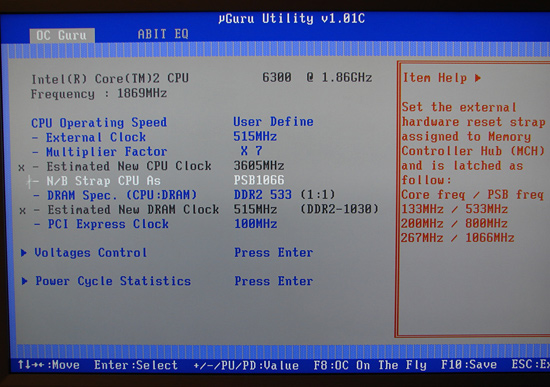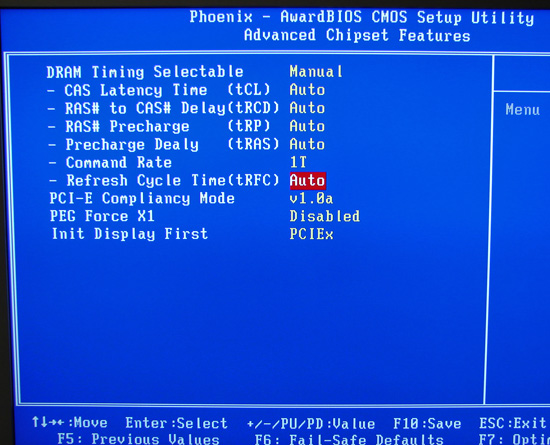Feature Set
abit has equipped this motherboard with a bevy of top end features and it is currently selling in the $219 range. The board features the Realtek ALC888 HD audio codec, Realtek RTL8810SC Gigabit Ethernet controller, dual e-SATA ports via the JMicron JMB363 chipset, and IEEE 1394 Firewire support. The accessory kit contains the basic SATA and IDE cables, external USB/Firewire bracket, and extensive documentation on the motherboard and µGuru functionality. However, abit did not include e-SATA cables and considering the cost of the kit we believe this in an omission.


The BIOS options for the AB9 QuadGT are fairly extensive for a motherboard in this sector, and of course the board features abit's excellent µGuru technology. The voltage options and availability of choices within each option will please the majority of enthusiasts. Besides memory voltage options up to 3.00V, the board also features the ability to change the command rate to 1T. In our initial testing we could not get 1T operation stable at DDR2-800 but were successful at DDR2-667 with a wide variety of Micron D9 based modules. However, we had trouble with several DDR2-667 modules based on Promos and Elpida memory ICs. The performance at DDR2-667 1T was equal to or up to 4% slower in several benchmarks when compared to DDR2-800 2T at the same memory latency timings. We believe abit still has significant tuning to complete to get 1T operating at DDR2-800 in a stable manner.
| abit AB9 QuadGT | |
| Market Segment: | Enthusiast Performance - $219.99 |
| CPU Interface: | Socket T (Socket 775) |
| CPU Support: | LGA775-based Pentium 4, Celeron D, Pentium D, Pentium EE, Core 2 Duo, Core 2 Extreme |
| Chipset: | Intel P965 + ICH8R |
| Bus Speeds: | 133 to 600 in 1MHz increments |
| Northbridge Strap: | CPU, 1066, 800, 533 |
| Memory Speeds: | SPD, 533, 667, 800 |
| PCIe Speeds: | 100 to 200 in 1MHz increments |
| PCI: | Fixed |
| Core Voltage: | Default, Base to 1.9250V in +.0100V increments |
| CPU Clock Multiplier: | Auto, 6x-11x in 1X increments if CPU is unlocked, Core 2 Duo downward unlocked |
| DRAM Voltage: | 1.800V to 3.000V in +.025V increments |
| DRAM- Ref Voltage: | +2%, 0%, -2%, -4% |
| DRAM Timing Control: | SPD, Manual, Auto or Manual for 6 DRAM Timing Options including Command Rate |
| MCH Voltage: | 1.25V to 1.70V in +.05V increments |
| CPU VTT Voltage: | 1.20V, 1.30V, 1.40V, 1.50V |
| ICH Voltage: | 1.05V, 1.10V, 1.15V, 1.20V |
| ICH IO Voltage: | 1.50V to 1.70V in +.05V increments |
| Memory Slots: | Four 240-pin DDR2 DIMM Slots Dual-Channel Configuration Regular Unbuffered Memory to 8GB Total |
| Expansion Slots: | 1 - PCIe x16 1 - PCIe x4 (x16 Physical) 1 - PCIe x1 2 - PCI Slot 2.3 |
| Onboard SATA/RAID: | 6 SATA 3Gbps Ports - RAID 0, 1, 5, 10 - Intel ICH8R 2 e-SATA 3Gbps Port - RAID 0, 1, JBOD - JMicron JMB363 |
| Onboard IDE: | 1 ATA133/100/66 Port (2 drives) - JMicron JMB363 |
| Onboard USB 2.0/IEEE-1394: | 10 USB 2.0 Ports - 4 I/O Panel - 6 via Headers IEEE 1394 - TI TSB43AB22A |
| Onboard LAN: | Realtek RTL8810SC - PCI Express Gigabit Controller |
| Onboard Audio: | Realtek ALC888 8-Channel HD Audio Codec |
| Power Connectors: | ATX 24-pin, 8-pin EATX 12V, 4-pin Molex |
| I/O Panel: | 1 x PS/2 Keyboard 1 x PS/2 Mouse 1 x CMOS Clear Switch 2 x S/PDIF Optical - In and Out 1 x IEEE 1394 Port 2 x e-SATA Port 1 x Audio Panel 1 x RJ45 4 x USB 2.0/1.1 |
| BIOS Revision: | Award 12/11/06 6A79LA1EC-10 |
abit has equipped this motherboard with a bevy of top end features and it is currently selling in the $219 range. The board features the Realtek ALC888 HD audio codec, Realtek RTL8810SC Gigabit Ethernet controller, dual e-SATA ports via the JMicron JMB363 chipset, and IEEE 1394 Firewire support. The accessory kit contains the basic SATA and IDE cables, external USB/Firewire bracket, and extensive documentation on the motherboard and µGuru functionality. However, abit did not include e-SATA cables and considering the cost of the kit we believe this in an omission.


The BIOS options for the AB9 QuadGT are fairly extensive for a motherboard in this sector, and of course the board features abit's excellent µGuru technology. The voltage options and availability of choices within each option will please the majority of enthusiasts. Besides memory voltage options up to 3.00V, the board also features the ability to change the command rate to 1T. In our initial testing we could not get 1T operation stable at DDR2-800 but were successful at DDR2-667 with a wide variety of Micron D9 based modules. However, we had trouble with several DDR2-667 modules based on Promos and Elpida memory ICs. The performance at DDR2-667 1T was equal to or up to 4% slower in several benchmarks when compared to DDR2-800 2T at the same memory latency timings. We believe abit still has significant tuning to complete to get 1T operating at DDR2-800 in a stable manner.










41 Comments
View All Comments
yyrkoon - Monday, January 22, 2007 - link
Oh, Gary, and Jarred, if you're thinking we, your readers are being harsh on you, well perhaps we are to an extent, but speaking for myself, this is because we care, and often look forward to your articles. So think of this as constructive criticism, and not outright flaming, please.Gary Key - Tuesday, January 23, 2007 - link
You are not being harsh. I changed the article back to "Conductive Polymer Aluminum Solid Capacitors" as abit finally confirmed the majority of the capacitors on the board are this type (I looked up the capacitor part numbers before hand but edited the article back the other way). I will update it when they confirm the three capacitors that did not match, they are solid but I have two boards each with different part numbers/suppliers on those three items. At times the manufacturers want us to use their marketing terminology as they might change components during production lot runs based on engineering changes or spot market pricing or to use layman's terms on the website. My previous articles on the Gigabyte boards used the correct terminology based on the capacitors on the board and we had an enormous amount of email and forum traffic asking why we stated something different than on Gigabyte's website at the time. We dumbed it down a little this time after a discussion and should not have. ;) Thanks for the comments and we do listen.yyrkoon - Monday, January 22, 2007 - link
Like the man said, Solid State is used when referring to Integrated Circuits, not Capacitors. The end result, is that you end up 'looking' like a fool, when someone who knows better sees this ( and possibly spread a minor form if 'mis-information).Think about it like this, what is the difference between a NAS, and a SAN ? Would you call a SAN, a NAS, in the company of enterprise IT geeks ? Probably not, at least, not without causing some confusion, or being corrected several times in the process . . .
Operandi - Monday, January 22, 2007 - link
Well they (caps suitable for motherbards) are either AL electrolyte or solid polymer based.Electrolyte caps are the more common type an actually contain electrolytic fluid which can leak when the cap fails. Polymer caps avoid that problem and also last longer -- to the laymen that would be the key difference.
Gary Key - Monday, January 22, 2007 - link
I have used the terminology, "Conductive Polymer Aluminum Solid Capacitors" in past articles and received several emails asking why we do not use what the manufacturers state on their websites as that term was deemed confusing. :)Stele - Monday, January 22, 2007 - link
Part of the problem lies in the confusion about the various kinds of capacitors of that category.Amongst the kind that we're concerned with on motherboards, graphics cards etc, we have the most basic: the aluminium electrolytic capacitor. Because this type started out with liquid electrolyte, the word "liquid" is generally omitted from the name as it is understood.
Then came the solid aluminium electrolytic capacitor, which replaced the liquid electrolyte with, well, a solid one - usually based on aluminium oxide. These are the type that we're nowadays excited about - the lack of liquid makes them more resistant to blow-outs and electrolyte leakage/dry-out, especially under prolonged, high temperature use. For short, they're sometimes referred to as merely "solid electrolytic" ("aluminium" is sometimes left out because, as noted above, the solid electrolyte is usually based on aluminium oxide and hence is understood as such) capacitors. To call them "solid capacitors" isn't totally useful because most capacitors are indeed solid objects :)
In conductive polymer capacitors, on the other hand, the dielectric is made from polymer foil (e.g. polypropylene, polyester, polystyrene, polycarbonate) coated with a layer of metal deposited on the surface. It follows that the basic conductive polymer capacitor has no liquid electrolyte inside - indeed there is no electroylte as the dielectric is purely the polymer foil.
However, manufacturers can and do mix in aluminium electrolyte with the polymer foil to improve certain performance characteristics; the electrolyte is often solid (rather than liquid) aluminium-based, hence "conductive polymer aluminium solid electrolytic capacitor".
As such, the exact names can mean quite distinct types of capacitors, and are not merely loose permutations of words like "electrolytic", "aluminium", "solid" and "polymer"... so if one wants to accurately describe a capacitor being used, one would need to double-check exactly what dielectric is being used in that capacitor :)
Marlin1975 - Monday, January 22, 2007 - link
Thats a understatement. The only thing i don't like about my 965 board is lack of IDE and the use of the jmicron junk.
One of the reasons I am waiting for more 650i boards and the ?last? ati chipset for Intel chips.
LoneWolf15 - Monday, January 22, 2007 - link
It's one of the reasons I'd still chose i975x rather than i965 for a chipset. i975X still has native Intel IDE.Due to recent nVidia chipset/board issues, and past issues with heat production, I'm not sure I'd choose them for an Intel board either, so that leaves the i975X as the only chipset I'd be comfortable with.
Numb3rs - Thursday, January 25, 2007 - link
Honestly, what in a new build would require and IDE interface..? eSATA is important and I am glad it's included. Abit has always made mobos dropping legacy devices no longer used by enthusiasts. Look at their old Abit "MAX" boards.
Why, in 2007 are manufacturers still using serial and parrallel I/O's..? Remove them completly and free the backplane for more useful eSATA, USB..etc
LoneWolf15 - Friday, January 26, 2007 - link
Obviously, you've never configured a Cisco router through its console port (which usually requires a serial port). And perhaps I don't want my list of optical drives confined to only SATA (currently Plextor and LiteOn are my only options, and I don't want one due to price and the other due to writing quality reasons).There are also some known issues with using Symantec Ghost on the JMicron chipset. Unless I hear they are worked out, that's an important thing to me too, and so IDE is still important to me. Just because it isn't useful to you doesn't mean it isn't to a lot of others.